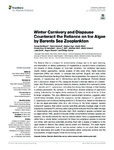Winter Carnivory and Diapause Counteract the Reliance on Ice Algae by Barents Sea Zooplankton
| dc.contributor.author | Kohlbach, D | |
| dc.contributor.author | Schmidt, K | |
| dc.contributor.author | Hop, H | |
| dc.contributor.author | Wold, A | |
| dc.contributor.author | Al-Habahbeh, AK | |
| dc.contributor.author | Belt, Simon | |
| dc.contributor.author | Woll, M | |
| dc.contributor.author | Graeve, M | |
| dc.contributor.author | Smik, L | |
| dc.contributor.author | Atkinson, A | |
| dc.contributor.author | Assmy, P | |
| dc.date.accessioned | 2021-03-24T15:02:02Z | |
| dc.date.available | 2021-03-24T15:02:02Z | |
| dc.date.issued | 2021-03-24 | |
| dc.identifier.issn | 2296-7745 | |
| dc.identifier.issn | 2296-7745 | |
| dc.identifier.other | 640050 | |
| dc.identifier.uri | http://hdl.handle.net/10026.1/16975 | |
| dc.description.abstract |
<jats:p>The Barents Sea is a hotspot for environmental change due to its rapid warming, and information on dietary preferences of zooplankton is crucial to better understand the impacts of these changes on food-web dynamics. We combined lipid-based trophic marker approaches, namely analysis of fatty acids (FAs), highly branched isoprenoids (HBIs) and sterols, to compare late summer (August) and early winter (November/December) feeding of key Barents Sea zooplankters; the copepods <jats:italic>Calanus glacialis</jats:italic>, <jats:italic>C. hyperboreus</jats:italic> and <jats:italic>C. finmarchicus</jats:italic> and the amphipods <jats:italic>Themisto libellula</jats:italic> and <jats:italic>T. abyssorum</jats:italic>. Based on FAs, copepods showed a stronger reliance on a diatom-based diet. Phytosterols, produced mainly by diatoms, declined from summer to winter in <jats:italic>C. glacialis</jats:italic> and <jats:italic>C. hyperboreus</jats:italic>, indicating the strong direct linkage of their feeding to primary production. By contrast, <jats:italic>C. finmarchicus</jats:italic> showed evidence of year-round feeding, indicated by the higher winter carnivory FA ratios of 18:1(n-9)/18:1(n-7) than its larger congeners. This, plus differences in seasonal lipid dynamics, suggests varied overwintering strategies among the copepods; namely diapause in <jats:italic>C. glacialis</jats:italic> and <jats:italic>C. hyperboreus</jats:italic> and continued feeding activity in <jats:italic>C. finmarchicus</jats:italic>. Based on the absence of sea ice algae-associated HBIs (IP<jats:sub>25</jats:sub> and IPSO<jats:sub>25</jats:sub>) in the three copepod species during both seasons, their carbon sources were likely primarily of pelagic origin. In both amphipods, increased FA carnivory ratios during winter indicated that they relied strongly on heterotrophic prey during the polar night. Both amphipod species contained sea ice algae-derived HBIs, present in broadly similar concentrations between species and seasons. Our results indicate that sea ice-derived carbon forms a supplementary food rather than a crucial dietary component for these two amphipod species in summer and winter, with carnivory potentially providing them with a degree of resilience to the rapid decline in Barents Sea (winter) sea-ice extent and thickness. The weak trophic link of both zooplankton taxa to sea ice-derived carbon in our study likely reflects the low abundance and quality of ice-associated carbon during late summer and the inaccessibility of algae trapped inside the ice during winter.</jats:p> | |
| dc.format.extent | 640050- | |
| dc.language.iso | en | |
| dc.publisher | Frontiers Media SA | |
| dc.subject | Calanus | |
| dc.subject | Themisto | |
| dc.subject | Barents Sea | |
| dc.subject | sea ice | |
| dc.subject | carbon sources | |
| dc.subject | trophic markers | |
| dc.subject | polar night | |
| dc.title | Winter Carnivory and Diapause Counteract the Reliance on Ice Algae by Barents Sea Zooplankton | |
| dc.type | journal-article | |
| dc.type | Journal Article | |
| plymouth.author-url | https://www.webofscience.com/api/gateway?GWVersion=2&SrcApp=PARTNER_APP&SrcAuth=LinksAMR&KeyUT=WOS:000637308400001&DestLinkType=FullRecord&DestApp=ALL_WOS&UsrCustomerID=11bb513d99f797142bcfeffcc58ea008 | |
| plymouth.volume | 8 | |
| plymouth.publication-status | Published online | |
| plymouth.journal | Frontiers in Marine Science | |
| dc.identifier.doi | 10.3389/fmars.2021.640050 | |
| plymouth.organisational-group | /Plymouth | |
| plymouth.organisational-group | /Plymouth/Faculty of Science and Engineering | |
| plymouth.organisational-group | /Plymouth/Faculty of Science and Engineering/School of Geography, Earth and Environmental Sciences | |
| plymouth.organisational-group | /Plymouth/REF 2021 Researchers by UoA | |
| plymouth.organisational-group | /Plymouth/REF 2021 Researchers by UoA/UoA07 Earth Systems and Environmental Sciences | |
| plymouth.organisational-group | /Plymouth/Research Groups | |
| plymouth.organisational-group | /Plymouth/Research Groups/Marine Institute | |
| plymouth.organisational-group | /Plymouth/Users by role | |
| plymouth.organisational-group | /Plymouth/Users by role/Academics | |
| plymouth.organisational-group | /Plymouth/Users by role/Researchers in ResearchFish submission | |
| dcterms.dateAccepted | 2021-03-02 | |
| dc.rights.embargodate | 2021-3-27 | |
| dc.identifier.eissn | 2296-7745 | |
| dc.rights.embargoperiod | Not known | |
| rioxxterms.versionofrecord | 10.3389/fmars.2021.640050 | |
| rioxxterms.licenseref.uri | http://www.rioxx.net/licenses/all-rights-reserved | |
| rioxxterms.licenseref.startdate | 2021-03-24 | |
| rioxxterms.type | Journal Article/Review |


